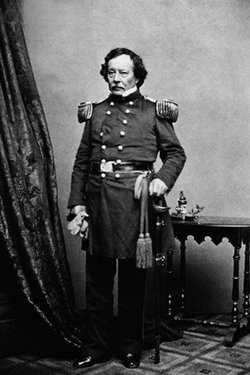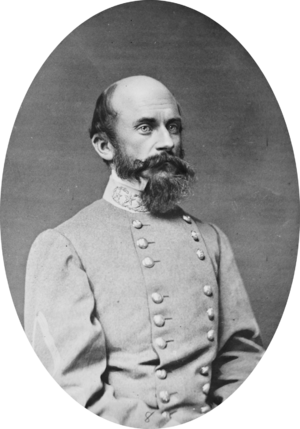Bonneville Expedition (1857) facts for kids
Quick facts for kids Bonneville Expedition |
|||||||
|---|---|---|---|---|---|---|---|
| Part of the Apache Wars | |||||||
 General Benjamin Bonneveille, circa 1861. |
|||||||
|
|||||||
| Belligerents | |||||||
| Apache | |||||||
| Commanders and leaders | |||||||
| Black Knife † | |||||||
| Strength | |||||||
| ~800 | unknown | ||||||
| Casualties and losses | |||||||
| 2 killed 7 wounded |
~50 killed or wounded 54 captured |
||||||
The Bonneville Expedition was a military mission by the United States Army in 1857. It marked the start of the Chiricahua Apache Wars. This expedition involved soldiers led by Colonel Benjamin Bonneville, Lieutenant Colonel Dixon S. Miles, and Colonel William W. Loring. They set out from Fort Fillmore in New Mexico Territory.
The soldiers quickly met Apache groups in two important battles. The first fight happened in the Black Range mountains. The second took place along the Gila River, near what is now Safford, Arizona. The expedition aimed to stop Apache raids in the area.
The Expedition Begins
In May 1857, Colonel Bonneville planned a large military operation. This was in response to ongoing raids by Apache groups. He gathered hundreds of soldiers at Fort Fillmore and Albuquerque.
The expedition was split into two main groups. Colonel Loring led the northern group, starting from Albuquerque. They headed towards the Mogollon Mountains. Lieutenant Colonel Miles commanded the southern group, which moved west along the Gila River. Colonel Bonneville traveled with Miles's group, but Miles was in charge of the southern column.
About 800 people were part of this expedition. This included infantry (foot soldiers), cavalry (soldiers on horseback), and Pueblo Scouts. About 600 of these troops were with Miles's southern column.
First Battle: Black Range
Colonel Loring's group was the first to encounter the Apache. They were tracking Chief Black Knife and his group. The Apache had stolen about 2,000 sheep.
On May 24, Loring's soldiers caught up with the Apache in the Black Range. They had been chasing them for several days. The Apache were attacked at their camp in a small, rocky valley. Seven Apache warriors were killed, and the rest escaped into the mountains. Chief Black Knife was among those killed. Nine other Apache were captured, and all the stolen sheep were recovered. No American soldiers were hurt in this fight.
Second Battle: Gila River
The southern group, led by Miles and Bonneville, had to wait longer for a battle. They moved more slowly. Colonel Bonneville had split his force into two parts. They marched closely together on both sides of the river. Some officers thought this tactic would make it hard to catch any Apache groups.
Captain Richard S. Ewell led the right side of the southern column. This group had about 300 men. On June 27, over a month after the expedition began, Ewell and his men found an Apache camp. It was located east of Mount Graham, along the Gila River.
Captain Ewell decided not to wait for the rest of the column. He and his men quickly attacked the Apache camp. In a short fight, about 40 Apache warriors were killed or wounded. Forty-five Apache women and children were also captured. Two American officers were killed, and seven enlisted men were wounded. It was believed that one of the killed Apache warriors was responsible for the death of Indian agent Henry I. Dodge.


